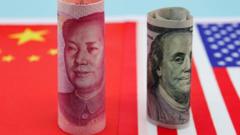A week-long engagement with the world’s leading financial figures at the International Monetary Fund provided a critical opportunity to assess the current global economic landscape. Discussions involved a broad spectrum of participants, including government ministers, central bankers, and key trade negotiators, all converging to deliberate on the future of international finance.
A noticeable undercurrent of anxiety permeated these high-level meetings. Despite the customary grandeur of the settings, including glimpses into traditionally opulent financial venues, there was a palpable sense of apprehension among many of the bankers and finance professionals present. This collective unease pointed towards significant uncertainties impacting markets and investments worldwide.
A prominent theme throughout the week’s discussions was the escalating geopolitical friction, particularly concerning the relationship between the United States and China. Reciprocal accusations and strategic disagreements between these economic giants were frequently cited as major factors contributing to global instability and trade challenges. The intensive interactions with these global finance elites offered a comprehensive, albeit complex, perspective on the immediate and long-term outlook for the world economy.



